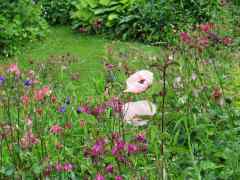
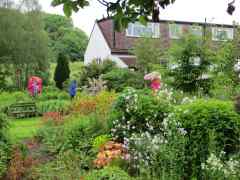
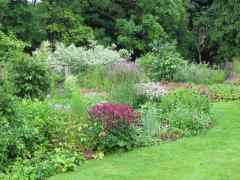
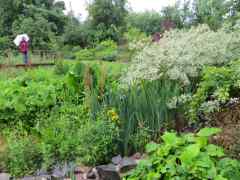
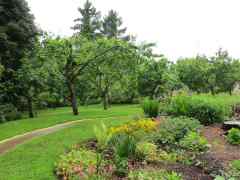
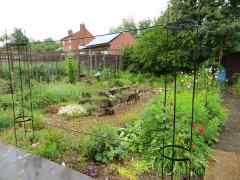
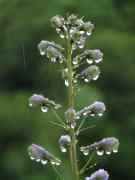
Two coffee mornings have been arranged this year and we are grateful to Wendy and Margaret who have offered to host them. They start at 10:30am and finish at 12:30pm. The cost is £2 (includes coffee), but you may also be asked for a contribution to, or to buy plants to support, the host's favourite charity.
Wendy Richards, The Hazels, Coopers Lane, Evesham WR11 6DA
I have a third of an acre garden, surrounding an Edwardian house, planted up in a cottage style. The soil is light and free-draining, so in a hot summer it’s a challenge to keep things going.
I find spring bulbs do well, so plant a lot of alliums and tulips, both in the borders and in pots, and I add to them each year. If you come and have a coffee in early May there should be quite a lot in flower if spring is kind to us.
Dr Margaret Stone, Brockamin, Old Hills, Callow End, Worcester WR2 4TQ
I moved to Brockamin in 1980, when the garden consisted mainly of grass with daffodils (planted in circles and straight lines) and a few fruit trees. There was a weeping willow in the centre and a line of five large leylandii with a hollow behind them, which had once been a rubbish pit. There appeared to be a large vegetable patch but close examination revealed that the top-soil had been stripped off.
New fruit trees were added but restricted to one area; garden compost was dug into the vegetable patch year on year. I created a large island bed and then, just as it was maturing, decided that I needed a herb garden in that position! That was invaded by brambles and damson suckers one summer and took many years to clear. Meanwhile, new borders gradually appeared; as I bought more plants, I dug up more grass. In 2000, the hollow became a pond/bog garden.
In 2007 I was given a collection of Erigerons and decided that the herb garden would become a collections garden; the Erigerons were joined by Aster novae-angliae and Geranium sanguineum. Geranium macrorrhizum and x cantabrigiense were planted in front of the leylandii. The plants gained Plant Heritage National Plant Collections status.
Then I decided to take out the conifers; the tree-surgeons dutifully avoided my plants, although there was little to see, this being January and February 2009. The bonfire burned for three weeks. Removing the (very large) trees changed the garden entirely and gave me a large new bed to develop! The willow stood majestically by itself. It may have been too exposed because the following year it dropped large branches, becoming dangerous and ugly; it had to go. Shade-loving plants were left in the sun but I had another area to plant! Before I could do so, a path was built around the garden (2011), involving a lot of digging up of turf, which was dumped on my willow area. I could not start planting until spring 2012 and am still extending the area by digging up more grass. I am also creating other borders in areas which have been neglected or overgrown by trees and shrubs. Thus, the garden is continually evolving but change has been rapid recently.